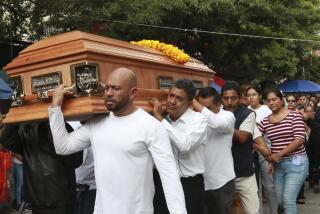Mexico’s president offers to meet with anti-violence movement
Reporting from Mexico City — A day after tens of thousands of Mexicans joined in anti-violence protests, President Felipe Calderon offered Monday to meet with organizers to explain a government drug war that has produced growing worry as deaths climb.
In televised comments, Calderon said talks could help bridge the gap between his administration and leaders of Sunday’s March for Peace, which drew crowds of violence-weary people to the streets to appeal for a new crime strategy.
Calderon offered no sign of backing away from his administration’s military-led crackdown against drug cartels. The conservative president, under fire amid widespread carnage, has insisted that yielding to the country’s violent drug traffickers is not an option.
“We can agree or disagree,” Calderon said. “Of course that doesn’t exclude the possibility and the responsibility to dialogue, to listen to each other and understand each other.”
Many Calderon critics hoped the Mexico City protest might mark a turning point in the 4-1/2-year-old drug war, which has killed more than 34,000 people since the president deployed troops to tackle crime groups. Most victims have died in fights between rival gangs over control of lucrative drug-smuggling routes to the United States.
Calderon did not address a key demand of the protesters — the resignation of Genaro Garcia Luna, Mexico’s public-safety secretary. A Calderon spokesman later praised Garcia Luna’s role in leading improvements of the federal police.
In a separate manifesto, organizers called on the government to solve slayings and disappearances; drop its “war strategy” in favor of a focus on citizen safety; battle corruption, impunity and money-laundering; and address social ills.
The protest was led by Javier Sicilia, a left-leaning poet and writer whose 24-year-old son was slain in the city of Cuernavaca in March alongside six other victims.
The demonstration increased pressure on Calderon. But some commentators said Sicilia did not offer clear alternatives and asked why he demanded the firing of Garcia Luna, for example, but not other military or political leaders.
On Monday, there were new signs of violence. Authorities in the northern state of Durango reported discoveries of 11 bodies in a mass grave in the state’s capital. At least 168 bodies have been unearthed there in a series of clandestine burial sites.
In addition, officials said six human heads were dumped next to a school in the capital, also named Durango.
In the northern state of Tamaulipas, where graves have yielded nearly 200 bodies recently, 12 gunmen and a Mexican marine were killed in a shootout at Falcon Lake, a dammed stretch of the Rio Grande straddling the border with Texas.
The gunfight erupted Sunday after Mexican naval personnel found a camp thought to belong to the Zetas drug gang, the Mexican navy said Monday.
Falcon Lake is where a U.S. citizen, David Hartley, was reported by his wife to have been pursued and shot by gunmen while jet-skiing last year. His body was not found. The area is used to smuggle drugs into the United States.
More to Read
Sign up for Essential California
The most important California stories and recommendations in your inbox every morning.
You may occasionally receive promotional content from the Los Angeles Times.










